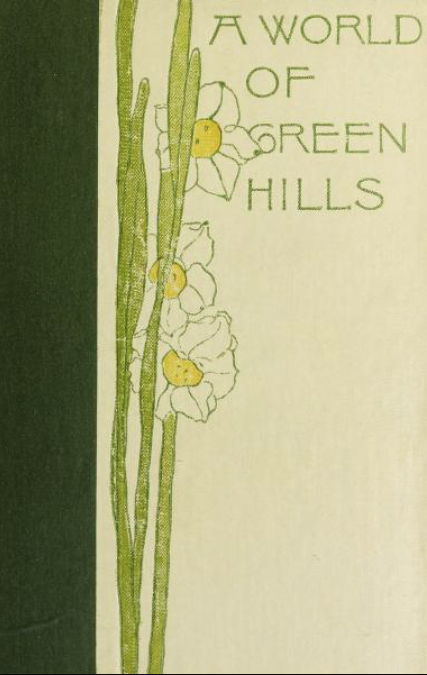

Stewart’s Pond, on the Hamburg road a mile or so from the village of Highlands, served me, a visiting bird-gazer, more than one good turn: selfishly considered, it was something to he thankful for; but I never passed it, for all that, without feeling that it was a defacement of the landscape. The Cullasajah River is here only four or five miles from its source, near the summit of Whiteside Mountain; and already a land- owner, taking advantage of a level space and what passes among men as a legal title, has dammed it (the reader may spell the word as he chooses — “ dammed ” or “ damned,” it is all one to a mountain stream) for uses of his own. The water backs up between a wooded hill on one side and a rounded grassy knoll on the other, narrows where the road crosses it by a rude bridge, and immediately broadens again, as best it can, against the base of a steeper, forest-covered hill just beyond. The shapelessness of the pond and its romantic surroundings will in the course of years give it beauty, but for the present everything is unpleasantly new. The tall old trees and the ancient rhododendron bushes, which have been drowned by the brook they meant only to drink from, are too recently dead. Nature must have time to trim the ragged edges of man’s work and fit it into her own plan. And she will do it, though it may take her longer than to absorb the man himself.
When I came in sight of the pond for the first time, in the midst of my second day’s explorations, my first thought, it must be confessed, was not of its beauty or want of beauty, but of sandpipers, and in a minute more I was leaning over the fence to sweep the water-line with my opera-glass. Yes, there they were, five or six in number, one here, another there; solitary sandpipers, so called with only a moderate degree of appropriateness, breaking their long northward journey beside this mountain lake, which might have been made for their express convenience. I was glad to see them.
Bradford Torrey was a master at the “ramble”, a genre of nature essay that, as the name suggests, rambled about. It had no particular objective beyond relating what Torrey saw and experienced on his outings into the natural world. Torrey’s world was dominated by what passed for a birding life-list in his day — he was constantly seeking out new species. He rarely observed them closely — identification was his primary goal. When birds were scarce, he noticed plants, particularly flowering ones. Very occasionally he mentioned some other other animal — for instance, a box turtle:
On Buck Hill, in the comparative absence of birds, I amused myself with a “dry land tarrapin,” as my West Virginia acquaintance had called it (otherwise known as a box turtle), a creature which I had seen several times in my wanderings, and had asked him about; a new species to me, of a peculiarly humpbacked appearance, and curious for its habit of shutting itself up in its case when disturbed, the anterior third of the lower shell being jointed for that purpose. A phlegmatic customer, it seemed to be; looking at me with dull, unspeculative eyes, and sometimes responding to a pretty violent nudge with only a partial closing of its lid. It is very fond of may apples (mandrake), I was told, and is really one of the “features” of the dry hill woods. I ran upon it continually.
While Torrey’s earliest essays explored familar haunts in Massachusetts (Torrey lived in Weymouth for most of his life), many of his later books feature his travels (by train, stagecoach, and foot) through various parts of the country that were beginning to find renown as touristed areas. Indeed, his accounts of his visits likely encouraged others to follow suit and take to the open road. A World of Green Hills was one of these accounts, based upon trips to the mountains of North Carolina and to Virginia (southwestern and the Natural Bridge area). In these later works, Torrey infused his nature observations with some of his notes on and conversations with the rural folk he chanced to meet along the way. They add a note of entertainment to what is otherwise a rather dry text — despite the “exotic” (for him) locales.
I have come to the conclusion that the ramble was very much a genre for its day, and its day has long passed. When Torrey published his book in 1898, reading was still one of the chief forms of entertainment for the urban and suburban middle and upper classes. In a time before radio and television, I can imagine a family gathering around a fireplace in the evening to listen to Torrey’s writings. They flow well and do not overly challenge the intellect. For all that I suspect he saw of changes in the land, Torrey rarely rebelled against the status quo. The opening passage of this blog post is a rare exception indeed. At another spot in this book, Torrey does observe how bird species appear to be changing in response to the clearing of forests, but here he offers no critique (if anything, I suspect that he welcomed what he perceived as an increase in avian biodiversity). Specifically, in comparing birds observed in North Carolina by William Brewster (a renowned ornithologist) many years previous, Torrey noted that
A few birds, too familiar to have attracted any particular notice on their own account, became interesting because of the fact that they were not included among those found here by Mr. Brewster. One of these was the Maryland yellow-throat, of which Mr. Brewster saw no signs above a level of 2100 feet… Probably the species had come in since Mr. Brewster’s day (eleven years before), with some change of local conditions, — the cutting down of a piece of forest, perhaps, and the formation of a bushy swamp in its place. A villager closely observant of such things, and well acquainted with the bird, assured me from his own recollection of the matter (and he remembered Mr. Brewster’s visit well) that such was pretty certainly the case.
Otherwise, I confess that I found little to share in this book. The ramble simply does not allow for in-depth explorations of ideas, issues, or even animal behaviors. Everything is cursory, in passing. The result may be ideal for a winter evening off-grid, but does not leave the reader much enriched in new insights. Still, may more Torrey volumes still await reading, and I will continue to seek out the few moments (like his dammed and damned passage above) where his observations and reflections shine.